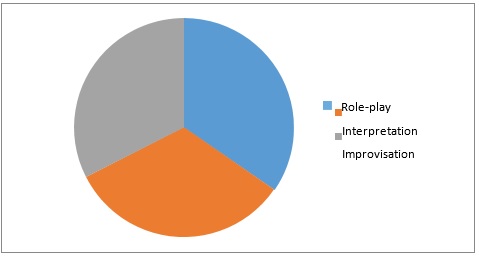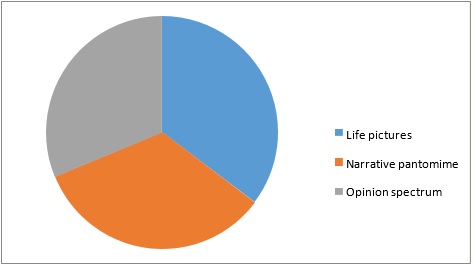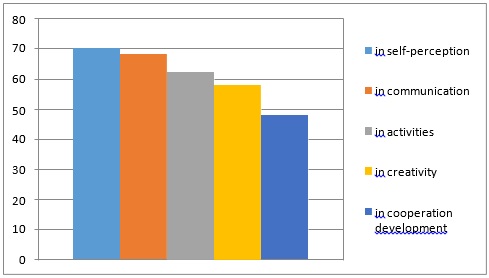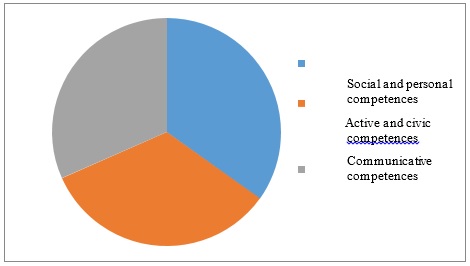Abstract
This article highlights the possibilities of the application of creative methods in pre-school education which are the essence of drama plays and which could enrich creativity of children and quality of education. The research goal is to find out if creative methods and items of creative drama, which give certain space for drama plays, in education are applied in kindergartens. The aim of the study is to analyse and evaluate the quality of creative methods application and to compare results with prior research in the field of creative drama. A comparative investigation where content analysis of kindergartens was done and a nonstandard questionnaire of the researcher’s construction for kindergarten teachers was used. The results were processed via descriptive methods and correlations. The research method monitored the application of creative methods and elements of creative drama in preschool education. Significant results emerged in application of creative methods which are the core of drama plays implemented in preschool education. Important correlations were demonstrated in the results based on selected indicators that highlighted possibilities of innovation in preschool education in the context of creative drama system implementation and support of creative methods of application in drama plays. These results can support the implementation of creative methods in preschool education with emphasis on drama play, which can improve the quality of creative thinking development of preschool children. A comparison of performed results will be beneficial for innovation of preschool education. The results of this study can increase interest in creative methods and elements of creative drama in teachers’ education.
Keywords: Preschool educationcreative methodsdrama playresearch
Introduction
Drama play is the core of aesthetic and educational system of creative drama and its application is of great importance in preschool education. Together with an improvisation and a role-play we can consider them to be the most important methods which can be used naturally, spontaneously by children or with a recommendation and projection of an educator. Drama play is based on a play itself which is the main child´s activity in preschool age.
Theoretical View at Drama Play
The word “drama” a certain predetermination for the play, caused with tension, which will result in a conflict between at least two players. There is negotiation or communication of mutual interaction with an entry to the roles and problem solving situations in a drama plot, which is so typical for a drama play. It addresses interpersonal relationships and issues, conflicts of attitudes, needs, imaginations and feelings. Valenta (2008) states, that drama play has concrete features such as a role, a conflict, a story – plays with conflict situation create the core of drama role plays. According to Machková (2007) a drama play is, i.e. a play based on interpersonal contact and communication, meetings of different human individuals in situations, persons who interact with each other – solve confrontations of their attitudes and needs, wishes, direction and creation of such a plot.
According to Valenta (2008) methods and techniques of drama education with the application and interconnection of principles of “drama” and “theatricality” can be applied in a drama play. Blahová (1996) interprets words of D. Svozilová, that construction of drama play and improvisation is based on principles of classical drama construction (according to Aristotle) and these are: exposure, collision, crisis, peripetism, catastrophe and subsequent catharsis. From the theoretical point of view a drama play has its substantiation and for its creative potential it deserves attention. In didactics of pre-school education the educational mean represents a method of active learning, that corresponds with situational and stage teaching method.
Play as a Starting Point for a Drama Play
Play is defined as the most natural form of an activity, which differs from work and learning. Man has been involved in a play for the whole life, but at a pre-school age it has a specific status – “it is the leading type of an activity and as a spontaneous child activity which gives the child immediate satisfaction, happiness, leases stress, brings a feeling of freedom, child can act initiatively, by trial-and-error learning s/he can try new ways of behaviour. (Mertin, Gillernová et al., 2010h, p. 53). Play has its basic characteristic features: voluntariness, freedom and spontaneity. Play is the most important child´s activity in pre-school age and its most natural activity. It is based on child´s internal need and free decision, it represents an outstanding feature of mental life where child´s personality is created and displayed. If the game is not sufficiently developed at home, it may happen that the child will languish. The true cause of these conditions is often difficult for parents to explain. Precisely, play has a significant role in education due to the reasons of preventive and therapeutic, psychological and emotional child´s deprivation. “A child who develops well, there is sustained upward dynamic of development being promoted, where positive influences of environment and upbringing contribute. Sudden changes and negative effects might lead towards interruption and delays in development and even a reversal. “(Opravilová, Gebhartová, p. 381, 2003).
Play can be used as a method to achieve didactic goals in education. It also has a diagnostic, therapeutic and relaxing function. Play which is started by a child itself has a significant importance. It is essential for the teacher to be aware of a play´s irreplaceability in pre-school education and s/he should respect the play, did not interrupt it forcibly and give the child sufficient space to play. The meaning of the play is wide: it gives the opportunity to discover, how things work, supports creativity and imagination, develops language and social behaviour, teaches the ability to solve problem, activates thinking, develops perceptional motor skills, strengthens coordination and fitness, it is a source of self-confidence, self-sufficiency and values, it allows you to communicate with others and to feel in other roles, teaches cooperation and communication with other children, stimulates search for knowledge, attention and concentration.
Play in a pre-school age is the most natural activity connected with mental development, cognitive processes and socialization. Play has a great importance in terms of social skills development. Children do not play side by side but they develop a cognitive play, communication and cooperation. The oldest children can divide roles and set goals, they gain a positive relationship to an activity. According to Opravilová, Gebhartová (2003) a child is an active being who has right to participate in its development. Learning situation means a way towards a certain goal. Usually, there is no problem to raise child´s interest in new phenomena, objects and activities. It is more difficult to keep its attention. Learning at pre-school age takes a form of spontaneous learning. Play is essential for a balanced personality development in pre-school period. Each play simulates in its way and therefore one can think of elements of drama play.
An educator leans about his/her children throughout a play. Diagnostic analysis might show a certain level of child´s development. If the educator is sufficiently responsive during the play, we can find out how the child pays attention, can concentrate, how s/he can use his/her experience, how s/he reacts to rules and commands. Many games/plays have rules and must be kept, if an individual does not follow them, s/he gets into a conflict. Games/plays with rules are important for character formation and in moral education. The result of the play is not important but its course, because it brings us pleasant feelings, satisfaction, happiness, spontaneity and freedom.
Situational learning takes place in a play, which creates a basis for a drama play and is foundation for continuous education. By a creative play and experimentation the child is gradually learning how to manage everything what s/he will need in life. Play may reveal child´s attention, his/her concentration, reactions to rules, speed in decisions making. Using play can show how the child is dealing with failure.
Play in the context with drama play gives a possibility to build on a personal experience, express a life image. The child mirrors a family and a life around him/her. Playing through a drama play develops child´s competences which can be applied in adulthood.
Creative Methods in Preschool Education
-
Drama play
In preschool drama or a theme play is typical and very often for children. It is usually supplemented by external features
Role play
Play in a role is also called a simulation and represents behaviour imitation, characteristics´ display with a goal to gain knowledge about functioning and ways of dealing. It is used most often in creative drama and scenic art. It also found its place in pedagogy, psychology and other fields such as in a term social not scenic. In education environment it is used as a method that allows a way of social behaviour and conduct, which is expected and assumed from a certain role. Role play takes place on a level of “like“ and the actor takes a role of somebody else. It represents how s/he would act and use own experience and knowledge for certain behaviour. A role-entry allows trying roles of opponents and also unavailable roles.
Improvisation
Improvisation is a creative method, because it enables an activity, dealing, action without preparation or offhand. It represents active, individual solution, suggestion making according to own ideas and possibilities, creative abilities with spontaneity, unwittingness, freedom and mostly voluntariness. It appears in every human activity and it is mainly visible in art and public life. It is one of the basic methods in creative drama, where objectives are achieved. It presents a way or a process that gives a chance to try new possibility with its own perception, consideration; acting what can the protagonist think of that right moment. Fantasy and imagination apply to be in a large extent. Improvisation is a mean to develop creativity.
Selected activating methods
Activating methods place children´s activity at the forefront. A frequent group is represented by
There is a certain existence of creative methods in preschool education which enable drama plays and we started to analyse and compare results from already made research survey in the field of creative drama such as in a term social not scenic. In education environment it is used as a method that allows a way of social behaviour and conduct, which is expected and assumed from a certain role. Role play takes place on a level of “like“ and the actor takes a role of somebody else. It represents how s/he would act and use own experience and knowledge for certain behaviour. A role-entry allows trying roles of opponents and also unavailable roles.
Improvisation
Improvisation is a creative method, because it enables an activity, dealing, action without preparation or offhand. It represents active, individual solution, suggestion making according to own ideas and possibilities, creative abilities with spontaneity, unwittingness, freedom and mostly voluntariness. It appears in every human activity and it is mainly visible in art and public life. It is one of the basic methods in creative drama, where objectives are achieved. It presents a way or a process that gives a chance to try new possibility with its own perception, consideration; acting what can the protagonist think of that right moment. Fantasy and imagination apply to be in a large extent. Improvisation is a mean to develop creativity.
Selected activating methods
Activating methods place children´s activity at the forefront. A frequent group is represented by
There is a certain existence of creative methods in preschool education which enable drama plays and we started to analyse and compare results from already made research survey in the field of creative drama.
Research Survey
Research survey within the specific research at Faculty of Education UHK should have revealed possibilities of preschool education in terms of setting up creative methods in education which create background for drama plays, have a positive effect on development of children creativity and contribute to education quality.
The aim of the research was to find out if creative methods and items of creative drama in kindergarten education are applied and give certain space for drama plays.
Research Questions
Are creative methods which are a prerequisite of drama play applied in preschool education? Are methods and techniques of drama education applied in kindergartens?
Research Results – interpretation and discussion
We present selected results from a conducted research survey which leads us to a reflection and a debate.
Question No. 1: What methods and techniques within the use of creative drama do you use the most? Tick in both provided subgroups (A and B) the three most common.
A) Methods:B) Techniques:
a) Interpretationa) Opinion spectrum
b) Improvisationb) Hot seat
c) Role-playc) Life pictures
d) Brainstormingd) A little street
e) Others (specify)e) Narrative pantomime
f) Pantomime
g) Others (specify)

Commentary: The most common method used within using items of creative drama in preschool education has shown to be a “role-play“, based on drama situation within drama plays, life stories and everyday situations. At the same time the play to be something or somebody reflects understanding of preschool children. Results have shown that the second most used method is an

Commentary: The technique of “life pictures“ seems to be the most used ones of drama education, that depicts one of the simplest and for preschool age acceptable technique based on performing a specific test, a particular scene and a picture. As for another most used technique the educators evaluated the technique of “narrative pantomime“, which gives children a possibility to complete a heard word, teaches them how to shape their own opinion and communicate. Further most used technique is represented by “opinion spectrum“, where children have a possibility to learn and perceive things around them so called “rough“, to put things in context and to create opinions, to incline towards a certain idea.
Question No. 2: When using items of creative dram in preschool education, where do you see the change of children? Tick five most frequent activities, characteristics: a) in creativity, b) in communication, c) in self-perception, d) in development of fine motor skills, e) in development of gross motor skills, f) in self-sufficiency, g) in activities, h) in development of cooperation, i) in development of relationships

Commentary: From the chart is clear that creative drama has a great impact on child´s personality development at preschool age. Educators have evaluated that creative drama firstly develops child´s self-concept, and then there is apparent change/shift in communication of children, where they get a chance to show off. Furthermore children are led to be active throughout creative drama, they should be involved within drama activities, enter into roles, create their own opinions. Creativity moved to a second place which has one of the top spots of development of healthy self-confident personality. And finally cooperation belongs to the development of personality assumption, when children learn how to cooperate with their peers through drama plays.
Question No. 3: What competences do you mostly fulfil on basis of creative drama use in children? Tick three most frequent competences: a) learning competence; b) competence of solving issues competence; c) communicative competence; d) social and personal competence; e) active and civic competences

Commentary: Evaluation results of question No. 3 clearly point to the fact that within the use of creative drama elements in kindergarten, the educators are aware of the fact that drama plays develop personality assumption within individual competences development, most social and personal competences, furthermore competences of activities and civic when drama play stimulates to an action, an activity. Another most frequent competence seems to be communication when a child through a perception learns to perceive feelings to express it verbally.
Research Methods
Methods and techniques used: Content analysis and a structured questionnaire of own constructions, which was monitoring application of creative drama elements in preschool education. Obtained data have been processed with the help of descriptive methods and correlations in NCSS10. Research sample: Kindergarten educators within the Czech Republic. There were 164 numbers of respondents.
Evaluation of Research Results
Research study has shown important findings that in preschool education means for implementing of drama plays are being used. Significant results have appeared in application of creative methods such as improvisation, interpretation and a role-play, creative drama techniques such as life pictures, narrative pantomime and opinion spectrum. Given methods and techniques emerged from research survey are the core of drama plays. Further significant fact of the research is that the educator is aware of creative drama benefits in child´s personal and social development and also
Conclusion
Research points out the opportunities to create conditions for intensive use of drama play as a creative method in preschool education. Results have shown the possibilities of innovation in preschool education in the context of system implementation of creative drama and supporting application of drama play. Based on selected indicators we will continue in results’ comparison which will be supported by important correlations in the context of the whole system of creative drama methods application in drama plays. Presentation of research outputs might support promotion of drama play and thinking about a deeper understanding in the methods and techniques application of creative method in preschool education.
Research results pointed out possibilities of innovation in preschool education with the emphasis on the realization of creative methods with the visualization of drama plays as a method.
Acknowledgments
This paper was supported by the Specific Research of the Faculty of Education of the University of Hradec Králové 2017, number 2107, entitled: Creative Drama as a Potential for the Development of Creativity of Children in Kindergartens.
References
- Bláhová, K. (1996). Uvedení do systému školní dramatiky. Praha: IPOS, 1996. ISBN 80-7068- 103-9
- Machková, E. (2007). Úvod do studia dramatické výchovy. 2., upravené vyd. Praha: NIPOS, 198 s. ISBN 978-80-7068-207-4.
- Mertin, V., Gillernová, I. et al. (2010). Psychologie pro učitelky mateřské školy. 2.rozš. vyd. Praha: Portál. ISBN 978-80-7367-627-8.
- Opravilová, E., Gebhartová, V. (2003). Rok v mateřské škole. Praha: Portál, ISBN 978-80-7367- 703-9.
- Valenta, J. (2008). Metody a techniky dramatické výchovy. Praha: Grada, ISBN 978-80-247- 1865-1.
- Vališová, Kasíková (2011). Pedagogika pro učitele. 2. rozšíř. vyd. Praha: Grada, ISBN 978-80- 247-3357-9.
Copyright information

This work is licensed under a Creative Commons Attribution-NonCommercial-NoDerivatives 4.0 International License.
About this article
Publication Date
16 October 2017
Article Doi
eBook ISBN
978-1-80296-030-3
Publisher
Future Academy
Volume
31
Print ISBN (optional)
-
Edition Number
1st Edition
Pages
1-1026
Subjects
Education, educational psychology, counselling psychology
Cite this article as:
Hornáčková, V. (2017). Drama Play A Creative Method In Preschool Education. In Z. Bekirogullari, M. Y. Minas, & R. X. Thambusamy (Eds.), ICEEPSY 2017: Education and Educational Psychology, vol 31. European Proceedings of Social and Behavioural Sciences (pp. 555-564). Future Academy. https://doi.org/10.15405/epsbs.2017.10.53

